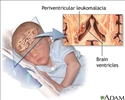Periventricular leukomalacia
PVL; Brain injury - infants; Encephalopathy of prematurity
Periventricular leukomalacia (PVL) is a type of brain injury that affects premature infants. The condition involves the death of small areas of brain tissue around fluid-filled areas called ventricles. The damage creates "holes" in the brain. "Leuko" refers to the brain's white matter. "Periventricular" refers to the area around the ventricles.
Causes
PVL is much more common in premature infants than in full-term infants.
A major cause is thought to be changes in blood flow to the area around the ventricles of the brain. This area is fragile and prone to injury, especially before 32 weeks of gestation.
Infection around the time of delivery may also play a role in causing PVL. The risk for PVL is higher for babies who are more premature and more unstable at birth.
Premature babies who have intraventricular hemorrhage (IVH) are also at increased risk for developing this condition.
Exams and Tests
Tests used to diagnose PVL include ultrasound and MRI of the head.
Treatment
There is no treatment for PVL. Premature babies' heart, lung, intestine, and kidney functions are watched closely and treated in the newborn intensive care unit (NICU). This helps reduce the risk of developing PVL.
Outlook (Prognosis)
PVL often leads to nervous system and developmental problems in growing babies. These problems most often occur during the first to second year of life. It may cause cerebral palsy (CP), especially tightness or increased muscle tone (spasticity) in the legs.
Babies with PVL are at risk for major nervous system problems. These are likely to include problems with movements such as sitting, crawling, walking, and moving the arms. These babies will need physical therapy. Some premature babies may have more problems with learning and behavior than with movement.
A baby who is diagnosed with PVL should be monitored by a developmental pediatrician or a pediatric neurologist. The child should see their regular pediatrician for scheduled exams.
References
Greenberg JM, Haberman B, Narendran V, Nathan AT, Schibler K. Neonatal morbidities of prenatal and perinatal origin. In: Resnik R, Lockwood CJ, Moore TR, Greene MF, Copel JA, Silver RM, eds. Creasy and Resnik's Maternal-Fetal Medicine: Principles and Practice. 8th ed. Philadelphia, PA: Elsevier; 2019:chap 73.
Hüppi PS, Gressens P. Cerebral white matter damage and encephalopathy of prematurity. In: Martin RJ, Fanaroff AA, eds. Fanaroff and Martin's Neonatal-Perinatal Medicine: Diseases of the Fetus and Infant. 12th ed. Philadelphia, PA: Elsevier; 2025:chap 54.
Merhar SL, Thomas CW. Nervous system disorders. In: Kliegman RM, St. Geme JW, Blum NJ, Shah SS, Tasker RC, Wilson KM, eds. Nelson Textbook of Pediatrics. 21st ed. Philadelphia, PA: Elsevier; 2020:chap 120.
Neil JJ, Volpe JJ. Encephalopathy of prematurity: clinical-neurological features, diagnosis, imaging, prognosis, therapy. In: Volpe JJ, Inder TE, Darras BT, et al, eds. Volpe's Neurology of the Newborn. 6th ed. Philadelphia, PA: Elsevier; 2018:chap 16.
Review Date: 12/31/2023




